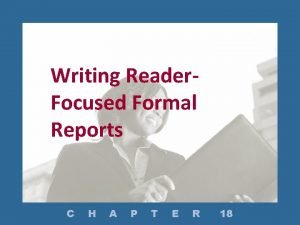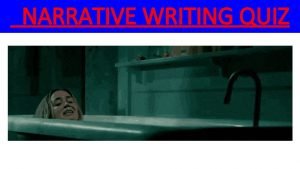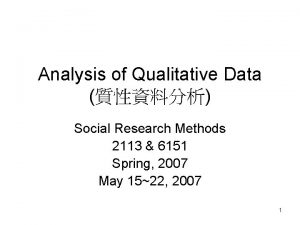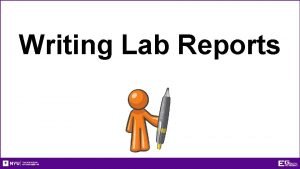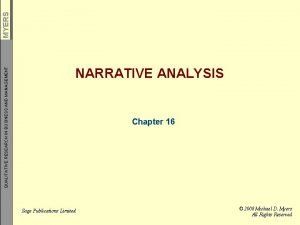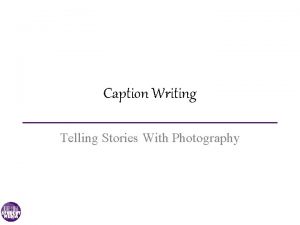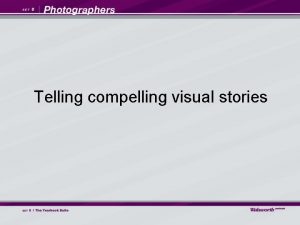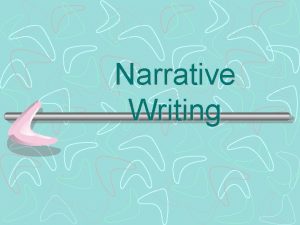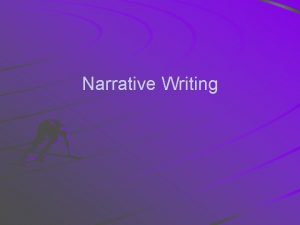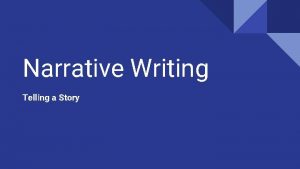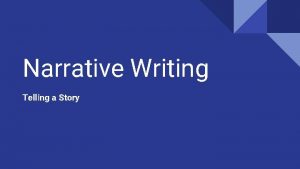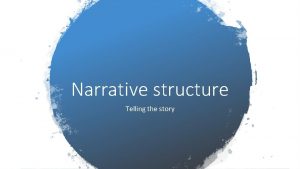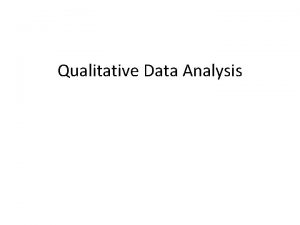Writing narrative reports Telling stories using qualitative data













- Slides: 13

Writing narrative reports Telling stories using qualitative data

Qualitative Data Analysis • Looks for common themes and patterns. • Sample quotations are used. • Categories of responses are identified and the number of responses that fall within these categories are identified. • No statistical analysis is required – but demographic information may be expressed in percentages or placed in tables.

Example of using quotes (from gang study in Sin City) One fourth of the youths surveyed said that they didn’t like gangs or didn’t want to join a gang. Almost 40% said that being in a gang was bad or stupid. One youth described being in a gang as a “dead end choice. ” Nine percent felt that being in a gang was dangerous or scary. One respondent said being in a gang was scary because “they always talk about killing or beating up other people. ” Only 6% of the respondents thought being in a gang was fun or was necessary for protection. However, one youth said that being in a gang made him feel “safe and good, cool to be around.

In the previous quote there were categories: • Didn’t like gangs • Gangs are bad or stupid • Being in a gang is fun

Analysis of Reading Assignment on the perspectives of front-line workers What were the authors studying? What was the purpose of the study What do the authors mean by “the clock is ticking”? In general, how did the workers perceive clients? What categories (typologies) did the authors used to describe these perceptions?

One approach to writing narratives can also include: • The writer’s own thoughts, values, and beliefs. • An interpretation of the research participant’s behavior or thoughts.

For example, this quotation from Fadiman, A. (1997). The spirit catches you and you fall down. New York: Farrar, Straus, & Giroux. While Foua was telling me about the dozens of tasks that constituted her “easy” work in Laos, I was thinking that when she said she was stupid, what she really meant was that none of her former skills were transferable to the U. S. – none, that is, except for being an excellent mother to her nine surviving children. It then occurred to me that this last skill had been officially contradicted by the American government, which had legally declared her a child abuser.

One approach to writing a narrative is “thick description” – creation of a picture of observed events, people involved, rules associated with certain activities, and social context. Thick description can also incorporate the researcher’s perspectives.

Our article on front-line workers provides a very basic level of analysis. For example, in the discussion section, the authors state: The participants' support for the agencies' emphasis on employment ("work first") came with several caveats, including its effectiveness for long-term welfare recipients and the need for some clients to receive additional preparation to be able to participate in the labor force, particularly if the goal is economic self-sufficiency. Similar concerns have been raised by others. Research findings based on AFDC recipients suggest that those most likely to reach the five-year limit tend to have less than a high school education, no or limited recent work experience, and young children (Pavetti, 1995; Petersen, 1995). For this group particularly, a labor force attachment strategy may be ineffective in fostering economic self-sufficiency. From: Hagen, J. , & Owens-Manley, J. (2002). Issues in implementing TANF in New York. Social Work, 47, 171 -182.

Compare the Hagen, J. , & Owens-Manley (2002) study to the following write-up using the thick narrative approach: Clients articulate their belief that the welfare system is not designed to help them succeed or care for their families…. Often it feels as if the information they received from workers is blatantly wrong. In one focus group, participants talked assuredly of the misinformation they had received …. As one women said“[The policy] is a lie. This what happens in the welfare system”…. Such a lack of trust raises serious questions about whether or not clients will heed front-line staff. From Sandfort, Kalil, & Gottschalk (1999). The mirror has two faces. Journal of Poverty, 3 (3), 71 -91.

A narrative or text-based summary should include • Identification of common themes in responses. • Patterns of behavior • Cultural or other symbols found in the setting or described by respondents. • Identification/description of cultural norms • Common words or phrases used by many respondents with sample quotations • Minority responses with sample quotations

Exercises for Thursday Look at the Yang article “A door swinging between two worlds” on Ereserve. Does the title of the article give away theme of this narrative? In your group, identify the places in the narrative where the author describes why she is swinging between both worlds.

Exercise 2: We are going to continue focus group interviews with the three questions we used two weeks ago: We will analysis a set of “raw” qualitative data by organizing it into categories and summarizing the findings in one written (narrative paragraph).
 Is a report formal or informal
Is a report formal or informal Fictional narrative essay
Fictional narrative essay Narrative quiz
Narrative quiz Presenting insights and findings using written reports
Presenting insights and findings using written reports Gerund story
Gerund story Quantitative data vs qualitative data comparison
Quantitative data vs qualitative data comparison Data
Data Purpose of writing reports
Purpose of writing reports Writing and completing reports and proposals
Writing and completing reports and proposals Prefatory elements
Prefatory elements Contoh laporan informasional
Contoh laporan informasional Twenty rules for writing detective stories
Twenty rules for writing detective stories Narrative data analysis example
Narrative data analysis example Accenture delivery data cube
Accenture delivery data cube
